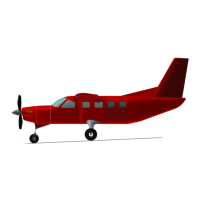2. The aircraft has been continuously parked or operated at or above
5°C since the last ight when the fuel system contained specied
concentrations of DIEGME anti-icing fuel additive, AND
3. Fuel ller port placards, shown in the placard section, comply with the
limitations given.
Table 2-7 – (Moved to “Section 1”)
If fuel with DIEGME is not used, the operator is required to use a biocidal
fuel additive given in “Section 1” of this manual. Any operation with fuel
that does not contain DIEGME will require the operator to verify appropriate
concentration levels of DIEGME in the aircraft’s fuel system, whenever this
component is reintroduced.
Table 2-8 – (Moved to “Section 1”)
Table 2-9 – (Moved to “Section 1”)
2-14 MAXIMUM OPERATING ALTITUDE LIMITATION
The certicated maximum operating altitude is 25,000 feet.
2-15 OUTSIDE AIR TEMPERATURE LIMIT
MINIMUM OUTSIDE AIR TEMPERATURE LIMIT
-55°C from sea level, to a pressure altitude of 25,000 feet.
MAXIMUM OUTSIDE AIR TEMPERATURE LIMIT
Ground Operations: +53°C from sea level, to 5000 feet. ISA +37°C above
5000 feet.
Flight Operations: ISA +35°C from sea level, to 25,000 feet.
NOTE: The landing lights are limited to operations at temperatures above
-40°C. Do not operate the landing lights at temperatures colder than -40°C.
WARNING: If the aircraft becomes exposed to temperatures below 5°C
for any length of time without an approved fuel system icing inhibitor, the
icing inhibitor must be reintroduced prior to next ight. After reintroducing
the icing inhibitor and verifying that the appropriate concentration levels
have been achieved, the operator shall perform the following checks prior
to next ight:
1. Inspect both fuel tanks for signs of ice and/or other contaminates.
2. Perform an engine run of at least 20 minute duration, during which the
engine is operated for at least 3 minutes at takeoff power levels.

